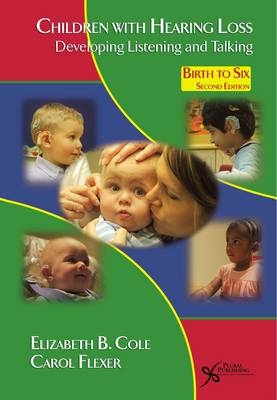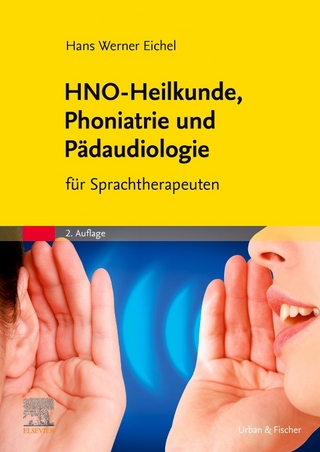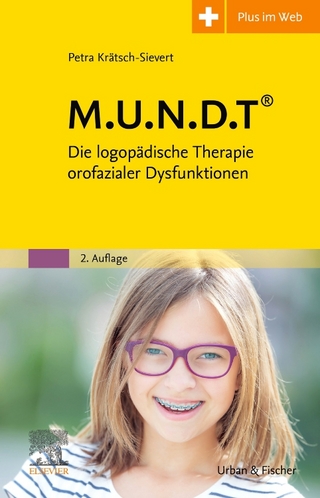
Children with Hearing Loss
Plural Publishing Inc (Verlag)
978-1-59756-379-6 (ISBN)
- Titel ist leider vergriffen;
keine Neuauflage - Artikel merken
In this day and age, we are dealing with a vastly different population of children with hearing loss, a population that never before in history have we had. With this new population, whose hearing loss is identified at birth, we can now prevent the developmental and communicative effects of hearing loss that were so common just a few years ago. With these babies and young children, we can now work primarily from a developmental and preventive perspective rather than from a remedial, corrective one. What has happened in the field of hearing loss is revolutionary. This second edition of Developing Listening and Talking, Birth to Six remains a dynamic compilation of crucially important information for the facilitation of auditorally-based spoken language for today's infants and young children with hearing loss. This text is intended for graduate level training programs for professionals who work with children who have hearing loss and their families (teachers, therapists, speech-language pathologists, and audiologists.)
In addition, the book will be of great interest to undergraduate speech-language-hearing programs, early childhood education and intervention programs, and parents of children who have hearing loss. Responding to the crucial need for a comprehensive text, this book provides a framework for the skills and knowledge necessary to help parents promote listening and spoken language development. This second edition covers current and up-to-date information about hearing, listening, auditory technology, auditory development, spoken language development, and intervention for young children with hearing loss whose parents have chosen to have them learn to listen and talk. Additions include updated information about hearing instruments and cochlear implants and about ways that professionals can support parents in promoting their children's language and listening development. Information about preschool program selection and management has been included. The text also features a revised auditory development checklist.A new appendix provides an important and useful tool for professionals who are interested in AG Bell Academy's Listening and Spoken Language Specialist Certification Program (LSLS) -- LSLS Cert.
AVT and LSLS Cert. AVEd. This appendix lists the competencies required for the LSLS, and references each chapter of the book with regard to those requirements. This book is unique in its scholarly, yet thoroughly readable style. Numerous illustrations, charts, and graphs illuminate key ideas. This second edition should be the foundation of the personal and professional libraries of students, clinicians, and parents who are interested in listening and spoken language outcomes for children with hearing loss.
Elizabeth Cole, EdD, is the Director of Soundbridge, a statewide public school program that provides a wide variety of services to approximately 600 children (birth through secondary school) who are learning spoken language through listening. She is also an Adjunct Professor at the University of Hartford, and for the First Years program at the University of North Carolina. Prior to coming to Connecticut in 1996, Dr. Cole was a professor at McGill University in Montreal for 16 years, where she taught acoustic phonetics, language, speech, and aural habilitation courses to students in the Auditory-Oral (Re-)Habilitation and Education of Hearing-Impaired Children (AORE) program, as well as to audiology and speech-language pathology students. Most of her published articles, chapters, and books have been focused on how to foster listening and spoken language development in young hearing-impaired children. Carol Flexer received her doctorate in audiology from Kent State University in 1982. She was at the University of Akron for 25 years as a distinguished professor of audiology in the School of Speech-Language Pathology and Audiology. Special areas of expertise include pediatric and educational audiology. She continues to lecture extensively nationally and internationally and has authored more than 150 publications. She has co-edited four books: How the Student with Hearing Loss Can Succeed in College, 1st and 2nd ed., and Sound-Field Amplification: Theory and Practical Applications, 1st and 2nd ed. She also has authored Facilitating Hearing and Listening in Young Children, 1st and 2nd ed. She is a past president of the Educational Audiology Association, a past board member of Auditory-Verbal International (Cert.Avt), and a past president of the American Academy of Audiology. Currently, she is a board member of the American Academy of Audiology Foundation, and president of the Alexander Graham Bell Association for the Deaf and Hard of Hearing Academy for Listening and Spoken Language. For her research and advocacy for children with hearing loss, Dr. Flexer received the Volta Award, the most prestigious award conferred by The Alexander Graham Bell Association for the Deaf and Hard of Hearing. Dr. Flexer also is a Certified Laughter Leader.
Neurological Foundations of Listening and Talking Key Points Presented in the Chapter Introduction Typical Infants: Listening and Language Development Auditory Neural Development Multiple Definitions for the Terms: New Context for the Word "Deaf" Hearing Versus Listening A Model of Hearing Loss: The Invisible Acoustic Filter Effect Summary: The Question That Drives Technological and Intervention Recommendations The Auditory System Key Points Presented in the Chapter The Nature of Sound Unconscious Function Signal Warning Function Spoken Communication Function Acoustics Audibility versus Intelligibility of Speech The Ling 6-7 Sound Test: Acoustic Basis and Description Ear Mechanisms Data Input Analogy Outer and Middle Ear Inner Ear to the Brain Hearing and Hearing Loss in Infants and Children Key Points Presented in the Chapter Introduction Classifications Degree (Severity) - Minimal to Profound Timing - Congenital or Acquired General Causes - Endogenous, Exogenous, or Multifactorial Genetics, Syndromes, and Dysplasias Connexin 26 Syndromes Inner Ear Dysplasias Medical Aspects of Hearing Loss Conductive Pathologies and Hearing Loss Sensorineural Pathologies and Hearing Loss Mixed, Progressive, Functional, and Central Hearing Losses Synergistic and Multifactorial Effects Auditory Neuropathy/Dyssynchrony (AN/AD) Summary Diagnosing Hearing Loss Key Points Presented in the Chapter Introduction Newborn Hearing Screening and EHDI Programs Test Equipment and Test Environment Audiologic Diagnostic Assessment of Infants and Children Test Protocols Pediatric Behavioral Tests: BOA, VRA, CPA, Speech Perception Testing Electrophysiologic Tests: OAE, ABR/ASSR, and Immittance The Audiogram Configuration (Pattern) of Thresholds on the Audiogram Formulating a Differential Diagnosis Sensory Deprivation Ambiguity of Hearing Loss Measuring Distance Hearing Summary Hearing Aids, Cochlear Implants, and FM Systems Key Points Presented in the Chapter Introduction For Intervention, First Things First: Optimize Detection of the Complete Acoustic Spectrum Listening and Learning Environments Distance Hearing/Incidental Learning and S/N Ratio ANSI S12.6-2002 Acoustical Guidelines Talker and Listener Physical Positioning Amplification Hearing Aids/Hearing Instruments Bone Anchored Hearing Aid (Baha) Assistive Listening Devices (ALDs): Personal-Worn FM and Sound Field FM and IR (Classroom Amplification) Systems Wireless Connectivity Cochlear Implants Measuring Efficacy of Fitting and Use of Technology Equipment Efficacy for the School System Conclusion Intervention Issues Key Points Presented in the Chapter Basic Premises Differentiating Dimensions Among Intervention Programs Educational Options for Children with Hearing Loss, Ages 3 to 6 Challenges to the Process of Learning Spoken Language Auditory "Work" Key Points Presented in the Chapter Introduction The Primacy of Audition The Acoustics-Speech Connection Intensity/Loudness Frequency/Pitch Duration The Effect of Hearing Loss on the Reception of Speech A Historical Look at the Use of Residual Hearing The Concept of Listening Age Auditory "Skills" and Auditory Processing Models Theory of Mind and Executive Functions How to Help a Child Learn to Listen in Ordinary, Everyday Ways Two Examples of Auditory Teaching and Learning Scene I: Tony Scene II: Tamara Targets for Auditory/Linguistic Learning A Last Word Spoken Language Learning Key Points Presented in the Chapter Introduction What's Involved in "Talking"? How Does a Child Learn to Talk? Relevance for Intervention Decisions How Should Intervention Be Organized? Constructing Meaningful Communication Key Points Presented in the Chapter Introduction The Affective Relationship The Child's Development of Interactional Abilities Joint Reference Turn-Taking Conventions Signaling of Intention Characteristics of Caregiver Talk 1. Content: What Gets Talked About? 2. Phonology: What Does Motherese Sound Like? 3. Semantics and Syntax: What about Complexity? 4. Repetition: Say It or Play It Again 5. Negotiation of Meaning: Huh? 6. Participation-Elicitors: Let's (Keep) Talk(ing) 7. Responsiveness Issues about Motherese How Long Is Motherese Used? Motherese: Why? Motherese: Immaterial or Facilitative? Interacting in Ways that Promote Listening and Talking: Parents, Therapists, and Teachers Key Points Presented in the Chapter Introduction The Emotional Impact of a Child's Hearing Loss on the Family What Parents Need to Learn Components of Intervention for Babies and Young Children with Hearing Loss When to Talk with Your Child and What to Talk About A Framework for Maximizing Caregiver Effectiveness in Promoting Auditory/Linguistic Development in Children with Hearing Loss Background and Rationale Structure of the Framework Getting a Representative Sample of Interacting Discussing the Framework with Parents Ways of Addressing Parent-Chosen Targets Teaching through Incidental and Embellished Interacting Teaching Through Incidental Interacting Teaching Through Embellished Interacting Parent Guidance Sessions or Auditory-Verbal Therapy Sessions Components to Be Accomplished in a Typical Preplanned Session Sample Preplanned Scenario Substructure About the Benefits and Limitations of Preplanned Teaching Appendix 1: How to Grow Your Baby's/Child's Brain Appendix 2: Application and Instructions for the Ling 6-7 Sound Test Appendix 3: Targets for Auditory/Verbal Learning Appendix 4: Explanation for Items on the Framework for Maximizing Caregiver Effectiveness Appendix 5: Checklist for Evaluating Preschool Group Settings Appendix 6: Selected Resources Appendix 7: Description and Practice of Listening and Spoken Language Specialists: LSLS Cert. AVT and LSLS Cert. AVEd. Appendix 8: Principles of LSLS Practice Appendix 9: Knowledge and Competencies Needed by Listening and Spoken Language Specialists (LSLS) Appendix 10: Listening and Spoken Language Domains Addressed in This Book References Glossary of Terms Index
| Erscheint lt. Verlag | 1.12.2010 |
|---|---|
| Zusatzinfo | b/w illustrations |
| Verlagsort | San Diego |
| Sprache | englisch |
| Maße | 152 x 229 mm |
| Gewicht | 617 g |
| Themenwelt | Medizin / Pharmazie ► Gesundheitsfachberufe ► Logopädie |
| Medizin / Pharmazie ► Medizinische Fachgebiete ► HNO-Heilkunde | |
| ISBN-10 | 1-59756-379-X / 159756379X |
| ISBN-13 | 978-1-59756-379-6 / 9781597563796 |
| Zustand | Neuware |
| Haben Sie eine Frage zum Produkt? |
aus dem Bereich


